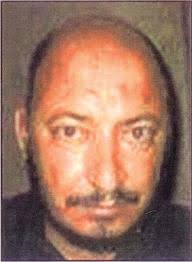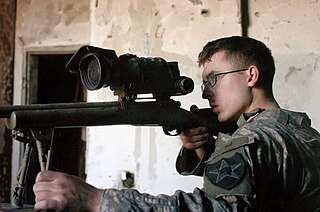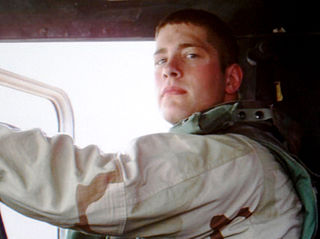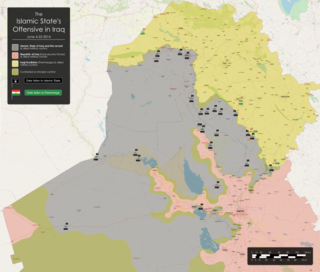
Wassef Ali Hassoun is a United States Marine who was charged with desertion for leaving his unit and engaging with others in a hoax to make it appear that he had been captured by terrorists on June 19, 2004, while serving in Iraq. Originally listed as having deserted, the Lebanese-born Marine was then thought to have been taken hostage by Iraqis who were thought to have befriended him.

The Triangle of Death is a name given to a region south of Baghdad during the 2003–2011 occupation of Iraq by the U.S. and allied forces which saw major combat activity and sectarian violence from early 2003 into the fall of 2007.

Abu Ayyub al-Masri, also known as Abu Hamza al-Muhajir, born Abdel Moneim Ezz El-Din Ali Al-Badawi, was the leader of Al-Qaeda in Iraq during the Iraqi insurgency, following the death of Abu Musab al-Zarqawi in June 2006. He was war minister of the Islamic State of Iraq from 2006 to 2010 and prime minister of the Islamic State of Iraq from 2009 to 2010. He was killed during a raid on his safehouse on 18 April 2010.

Abu Omar al-Baghdadi, born Hamid Dawud Mohamed Khalil al-Zawi was the Emir of the Islamic militant umbrella organization Mujahideen Shura Council (MSC), and its successor, the Islamic State of Iraq (ISI), which fought against the U.S.-led Coalition forces during the Iraqi insurgency.

Ahmed Kousay Al-Taie was a United States Army soldier who was kidnapped in October 2006 in Baghdad and later killed by his captors; as of November 2021, he was the latest missing U.S. serviceman from the Iraq War to be recovered.
The 2003 invasion of Iraq, which lasted from March 20 to May 1, 2003, resulted in a small number of U.S. and Coalition Prisoners of war.

The Battle of Haifa Street was fought during January 2007 for the control of Haifa Street, a two-mile-long street in downtown Baghdad, Iraq, pitting American and Iraqi Army forces against various Sunni insurgent forces between January 6 and January 9, 2007, and then two weeks later on January 24 when US forces launched a second attempt to clear Haifa Street of insurgents once and for all. This battle was the precursor for clearing operations that would set the conditions for "the surge" which ultimately neutralized insurgent groups in this part of Baghdad during the spring and summer of 2007.
The Karbala provincial headquarters raid was a special operation carried out on January 20, 2007, by the Asa'ib Ahl al-Haq against the U.S. contingent of the Joint Security Station, located within the Iraqi Police headquarters. The assault, which left five U.S. soldiers dead and three wounded, has been called the "boldest and most sophisticated attack in four years of warfare" and is furthermore notable for being one of the few instances when any sort of militants or insurgents have actually managed to capture U.S. soldiers since the Vietnam War.

Operation Phantom Strike was a major offensive launched by the Multi-National Corps – Iraq on 15 August 2007 in a crackdown to disrupt both the al-Qaeda-affiliated Islamic State of Iraq and Shia insurgent operations in Iraq. It consisted of a number of simultaneous operations throughout Iraq focused on pursuing remaining ISI terrorists and Iranian-supported insurgent groups. It was concluded in January 2008 and followed up with Operation Phantom Phoenix.

Tanzim Qaidat al-Jihad fi Bilad al-Rafidayn, more commonly known as Al-Qaeda in Iraq, was a Salafi jihadist organization affiliated with Al-Qaeda. It was founded on 17 October 2004, and was led by Abu Musab al-Zarqawi and Abu Ayyub al-Masri until its disbandment on 15 October 2006.
Operation Phantom Phoenix was a major nationwide offensive launched by the Multinational Force Iraq (MNF-I) on 8 January 2008 in an attempt to build on the success of the two previous corps-level operations, Operation Phantom Thunder and Operation Phantom Strike and further reduce violence and secure Iraq's population, particularly in the capital Baghdad. The offensive consisted of a number of joint Coalition and Iraqi Army operations throughout northern Iraq as well as in the southern Baghdad Belts.
The 2008 Nineveh campaign was a series of offensives and counter-attacks between insurgent and Coalition forces for control of the Nineveh Governorate in northern Iraq in early-to-mid-2008. Some fighting also occurred in the neighboring Kirkuk Governorate.

The 2004 Good Friday ambush was an attack by Iraqi insurgents on April 9, 2004 during the Iraq War on a convoy of U.S. supply trucks during the Battle of Baghdad International Airport. It happened in the midst of the Iraq spring fighting of 2004, which saw intensified clashes throughout the country.

The Iraqi insurgency was an insurgency that began in late 2011 after the end of the Iraq War and the withdrawal of U.S. troops from Iraq, resulting in violent conflict with the central government, as well as low-level sectarian violence among Iraq's religious groups.

Operation al-Shabah was launched in May 2013 by the Iraqi Army, with the stated aim of severing contact between the Islamic State of Iraq and the Levant and the al-Nusra Front in Syria by clearing militants from the border area with Syria and Jordan.

The Islamic State of Iraq, was a Salafi jihadist militant organization that fought the forces of the U.S.-led coalition during the Iraqi insurgency. The organization aimed to overthrow the Iraqi federal government and establish an Islamic state in Iraq.

The Northern Iraq offensive began on 4 June 2014, when the Islamic State of Iraq and Levant, assisted by various insurgent groups in the region, began a major offensive from its territory in Syria into Iraq against Iraqi and Kurdish forces, following earlier clashes that had begun in December 2013 involving guerillas.
In early 2014, the jihadist group Islamic State of Iraq and the Levant captured extensive territory in Western Iraq in the Anbar campaign, while counter-offensives against it were mounted in Syria. Raqqa in Syria became its headquarters. The Wall Street Journal estimated that eight million people lived under its control in the two countries.
This article contains a timeline of events from January 2015 to December 2015 related to the Islamic State of Iraq and the Levant (ISIL/ISIS). This article contains information about events committed by or on behalf of the Islamic State, as well as events performed by groups who oppose them.
The origins of the Islamic State group can be traced back to three main organizations. Earliest of these was the "Jamāʻat al-Tawḥīd wa-al-Jihād" organization, founded by the Jihadist leader Abu Mus'ab al-Zarqawi in Jordan in 1999. The other two predecessor organizations emerged during the Iraqi insurgency against the U.S. occupation forces. These included the "Jaish al-Ta'ifa al-Mansurah" group founded by Abu Omar al-Baghdadi in 2004 and the "Jaysh Ahl al-Sunnah wa’l-Jama’ah" group founded by Abu Bakr al-Baghdadi and his associates in the same year.

















